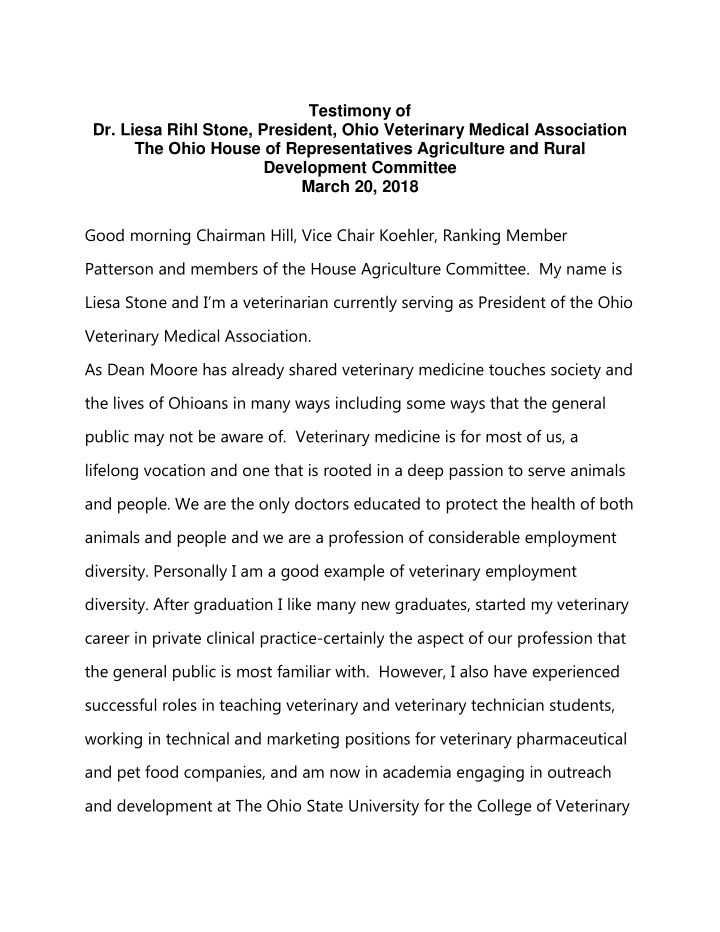



Testimony of Dr. Liesa Rihl Stone, President, Ohio Veterinary Medical Association The Ohio House of Representatives Agriculture and Rural Development Committee March 20, 2018 Good morning Chairman Hill, Vice Chair Koehler, Ranking Member Patterson and members of the House Agriculture Committee. My name is Liesa Stone and I’m a veterinarian currently serving as President of the Ohio Veterinary Medical Association. As Dean Moore has already shared veterinary medicine touches society and the lives of Ohioans in many ways including some ways that the general public may not be aware of. Veterinary medicine is for most of us, a lifelong vocation and one that is rooted in a deep passion to serve animals and people. We are the only doctors educated to protect the health of both animals and people and we are a profession of considerable employment diversity. Personally I am a good example of veterinary employment diversity. After graduation I like many new graduates, started my veterinary career in private clinical practice-certainly the aspect of our profession that the general public is most familiar with. However, I also have experienced successful roles in teaching veterinary and veterinary technician students, working in technical and marketing positions for veterinary pharmaceutical and pet food companies, and am now in academia engaging in outreach and development at The Ohio State University for the College of Veterinary
Medicine. I also contribute to organized veterinary medicine by fulfilling a volunteer role as president of the OVMA. In each of these roles, I was selected because I was a veterinarian. Today across our state you will find veterinarians working in a broad range of diverse disciplines. A large number of veterinarians are employed in private or corporate clinical practice managing the health of animals. This includes maintaining the important human-animal bond through caring for pets or guaranteeing a safe farm to table food supply by working with farmers and ranchers insuring the health of their herds and flocks. Veterinary medicine has veterinary specialties that mirror human specialties and it is not uncommon for your cat to see a veterinary oncologist for chemotherapy, your dog to see a veterinary orthopedic surgeon for a total hip replacement or for your horse to have an MRI to diagnose lameness. There are also many veterinary professionals hard at work in research facilities, universities and biopharmaceutical companies developing the next breakthrough vaccine or drug treatment or advancing medical discoveries that directly benefit both animals and people. It was a veterinarian that identified the cause of West Nile Virus. We are also at work in federal and state government agencies like the Ohio Department of Agriculture and USDA-APHIS protecting Ohio’s animals and humans by insuring compliance, testing for diseases, monitoring inspection programs and overseeing shipments of animals, all to prevent diseases that could threaten
Ohio’s food supply and the health of Ohio’s animals and people. We often serve as public health commissioners because our training reflects not just disease diagnosis and transmission among animals but also diseases that can spread between people and animals. We investigate disease outbreaks and evaluate safety of water supply. So where do veterinarians work in Ohio — we work everywhere: we work in zoos, at state fairs, at horse barns, on military bases, at animal shelters, in animal drug and product companies, at universities, on farms, in clinics-just to name a few. As you can see veterinary medicine impacts the lives of Ohioans each and every day. Considering the scope of this profession it should come as no surprise that veterinary medicine employs over 23,000 individuals in Ohio and provides more than $2.4 billion in economic activity. And since this is the House Agriculture and Rural Development Committee I would be remiss if I did not offer a few more insights into the key role that veterinary medicine plays in supporting Ohio’s largest economic contributor, agriculture. It is no secret that Ohio ranks at or near the top in many agricultural production categories whether it be dairy, eggs, pork, beef, chicken, sheep or even llamas, veterinarians are at the forefront supporting Ohio’s farmers in formulating optimal nutrition plans, helping with biosecurity protocols, offering guidance with optimal housing systems, treating just one sick cow or addressing disease in an entire heard. Veterinarians serve as a valued and integral partner with agricultural
producers to provide a safe food supply and a rewarding vocation for Ohio’s fa rmers. It is this key role in assisting Ohio agriculture which more than anything adds to the total of over $13 billion in direct and indirect contributions veterinary medicine makes to Ohio’s economy each year. Like agriculture, veterinary medicine is a vital industry in Ohio. The billions of dollars and thousands of jobs it provides and supports is integrated in a profession of considerable diversity of discipline and one that touches every community and every person in our great Buckeye state. This most recent economic study reaffirms what intuitively has been known by many, veterinary medicine not only advances a healthy Ohio it also provides for a healthy Ohio economy. In further support of Dean Rustin Moore’s comments, we are very fortunate to have one of the 30 national veterinary colleges in our State. Because of this we have research discoveries occurring daily-right here in Columbus, we have veterinary experts immediately available if our leading economic industry-agriculture is threatened by serious disease outbreak and we have many of the best educated veterinarians practicing in our Buckeye state. Thank you Chairman Hill and members of the Committee for this opportunity and for your attention. Dean Moore and I would be happy to answer any questions.
Recommend
More recommend